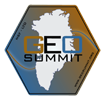| PI | Institute/Department | |
|---|---|---|
| Hawley, Robert |
Dartmouth College, Department of Earth Sciences
|
| Program Manager | Funding Agency | |
|---|---|---|
| Delgado, Dr. Roberto |
NSF
|
In understanding the large-scale changes of the Greenland Ice Sheet, wide coverage is needed. While aircraft and satellites produce extensive elevation-change datasets, and regional climate models predict snowfall at high resolution, both systems require calibration and validation by on-the-ice means. Hence, there is a need for extensive on-ice elevation survey data in Greenland, typically collected using the Global Positioning System (GPS). Ground-based traverses have been highly successful in collecting such on-ice information. Similarly, on-ice static GPS stations have been installed for short-term glaciology projects. Both approaches, however, suffer significant drawbacks. The first is cost. Ground traverses are logistically complex and expensive. For traditional static stations, the high cost is associated with the hardware and the transport of large numbers of batteries due to the power required to run these stations through the dark winter. The second is limitations in spatial and temporal coverage. Traverses offer excellent spatial coverage, but temporally only a single snapshot in time over the traverse route. Conversely, static stations offer excellent temporal resolution, but operate at a fixed point and thus limited spatial resolution.
This project will create a dense network of static on-ice GPS stations in Greenland. New GPS technology allows for a reduction in costs by leveraging the newest generation of chipsets, which offer extremely low power consumption. While currently unproven for collecting science data on ice sheets, these chipsets are now integrated in the current generation of Unmanned Aerial Vehicles (UAVs) and, when operated using Real Time Kinematic (RTK) corrections in these situations, claim centimeter-scale positioning accuracy. Over three phases, the project will 1) install a network of stations in the study area; 2) develop a standalone GNSS receiver station for deployment outside the original network; and 3) deploy a wider network of stations on the Greenland Ice Sheet. This project will also integrate research and education by supporting a graduate student who will be actively involved in all aspects of the project, and by partnering with the Women in Science Project to train a first-year female undergraduate student during a 20-week internship in each year of the project.
Over three years of the project (2022-2024), the project team will install and service a total of 40 instrument sites, off-station but within the Summit Station area allotment, to measure changes in snow surface height and surface mass balance. These sites will operate autonomously and transmit data back to the PI institution through the Vieregg RNO-G communications network and the existing Summit Station satellite network link.
In 2022, a field team of two will travel to Summit for approximately two weeks in July- August for one week.
In 2023, the research team will travel to Summit Station to perform maintenance and service on the project’s off-station instrument array. This work will be performed as daytrips, with the team sleeping at Summit Station each night. While working at Summit Station, the team will use a workbench in a heated indoor workspace to perform instrument testing and service activities.
In 2024, a field team of two will return to Summit for a demobilization visit. During each of these visits, the science team will use a snowmobile equipped with the PolyPod shelter sled to travel to their instrument sites located from 1 km to 9 km from Summit Station. This work will be performed as daytrips, with the team sleeping at Summit Station each night. While at the station, the team will use a workbench in a heated indoor workspace with a network connection. As the instruments are designed for autonomous operation, minimal contractor science technician support is anticipated.
Battelle ARO will provide Air National Guard (ANG) coordination for passengers and cargo; lodging in Kangerlussuaq, Summit Station user days; science technician support; physical space, power, and network connection in the Mobile Science Facility (MSF); use of NSF snowmachines; fuel; and use of communications and safety gear from the NSF inventory. All other logistics will be arranged and paid for by the PI from the research grant.
| Season | Field Site | Date In | Date Out | #People |
|---|---|---|---|---|
|
2022
|
Greenland - Summit
|
|
|
3
|
|
2023
|
Greenland - Summit
|
|
|
2
|
|
2024
|
Greenland - Summit
|
|
|
2
|
